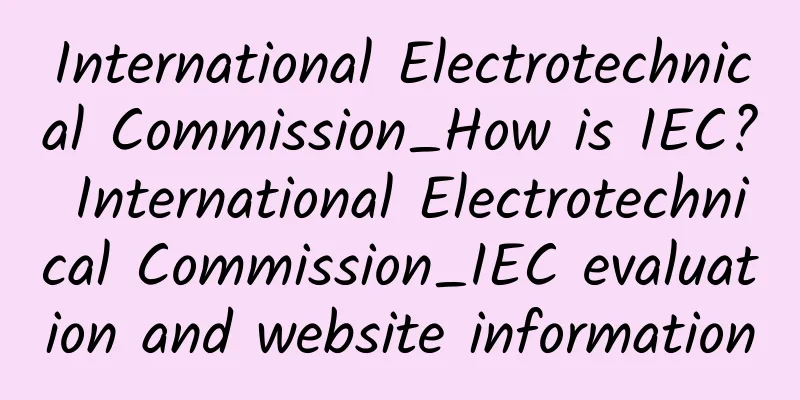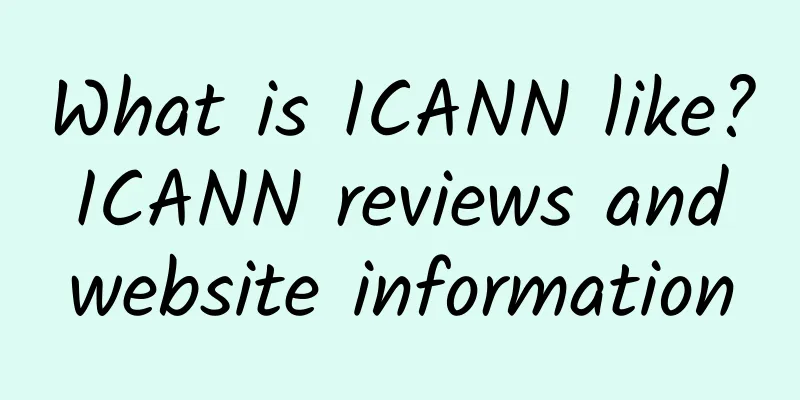International Electrotechnical Commission_How is IEC? International Electrotechnical Commission_IEC evaluation and website information

|
International Electrotechnical Commission_What is IEC? The International Electrotechnical Commission (IEC) is an international standardization organization established in 1906 and headquartered in Geneva, Switzerland. It is mainly responsible for international standardization work in the fields of electrical engineering and electronic engineering. Website: www.iec.ch International Electrotechnical Commission (IEC): A pioneer in global electrical and electronic engineering standardizationIn today's rapidly developing technological era, electrical and electronic technologies have become the core force driving global economic and social progress. However, the widespread application of these technologies is inseparable from a unified standard system. It is in this context that the International Electrotechnical Commission (IEC) came into being and became the core organization for setting standards in the global electrical and electronic fields. This article will explore the historical background, organizational structure, core functions of the IEC, and its important position in the process of globalization. The origin and development of IECThe International Electrotechnical Commission was founded in 1906 and is headquartered in Geneva, Switzerland. As a non-governmental international standardization organization, IEC is committed to developing global unified standards for technologies and products in the electrical and electronic fields. Its establishment stems from the growing demand for international electrical equipment trade at the time and the urgent need to ensure the safety and compatibility of these devices. In the early 20th century, with the rapid development of the power industry, the interoperability of electrical equipment between countries gradually emerged. Different countries adopted different voltages, frequencies and plug designs, which led to huge obstacles in international trade and technical exchanges. In order to meet this challenge, technical experts from all over the world came together to discuss the establishment of an international organization that could coordinate the standards of various countries. After many meetings and consultations, the IEC was finally established, marking a new era in global electrical standardization. IEC's core functions and objectivesAs one of the most important international standardization organizations in the electrical and electronic fields, the core functions of IEC can be summarized as follows:
The goal of IEC is to eliminate technical barriers through standardization, promote international trade and technology transfer, and thus achieve coordinated development of technology on a global scale. In addition, IEC also pays special attention to the research of emerging technologies, such as artificial intelligence, the Internet of Things, and smart grids, to ensure that its standard system can keep pace with the times and meet the needs of future technological development. IEC's organizational structureThe operation of IEC relies on a well-designed organizational structure to ensure that its activities can be carried out efficiently and transparently. The following is the main organizational structure of IEC:
This multi-level organizational structure enables the IEC to maintain flexibility while ensuring the fairness and scientific nature of its decision-making process. IEC Standard Development ProcessThe development of IEC standards is a rigorous and complex process that usually requires multiple stages to complete. The following are the main steps in standard development:
The entire process may take months or even years, but it is this rigorous procedure that ensures the authority and reliability of IEC standards. IEC's role in globalizationAs the trend of economic globalization continues to deepen, the role of IEC in promoting international trade and technical cooperation has become increasingly prominent. The following are some specific manifestations:
In addition, IEC maintains close cooperation with other international organizations such as ISO (International Organization for Standardization) and ITU (International Telecommunication Union), jointly building a global standardization network covering a wide range of fields. IEC website: www.iec.chThe most direct way to learn more about IEC and its activities is to visit its official website ( www.iec.ch ). The website provides a wealth of resources and information, including:
Both industry practitioners and the general public can find valuable information on the IEC website to better understand the impact of electrical and electronic technologies on modern society. ConclusionAs the leader of global electrical and electronic standardization, the International Electrotechnical Commission (IEC) has played an irreplaceable role over the past century. It not only provides unified technical specifications for countries and promotes international trade and technical exchanges, but also makes outstanding contributions to promoting scientific and technological innovation and sustainable development. In the future, with the continuous advancement of technology and the further deepening of globalization, IEC will continue to shoulder the responsibility of leading the development of the industry and create a better tomorrow for human society. |
<<: austriamicrosystems_AMS review and website information
>>: What is the Peace Foundation like? Peace Foundation reviews and website information
Recommend
What is Croatia Airlines like? Croatia Airlines reviews and website information
What is Croatia Airlines? Croatia Airlines (Croati...
Wolfberry porridge
Have you ever tasted wolfberry porridge? Let me i...
The efficacy and function of ten-year tangerine peel
Tangerine peel is a traditional Chinese medicine ...
The nutritional value and efficacy of mandarin fish. Precautions for eating mandarin fish
Mandarin fish is a carnivorous fish with scales, ...
How to eat oatmeal rice How to make oatmeal rice delicious
Oatmeal is a common rice ingredient in life. It h...
What is the shelf life of mooncakes?
Eating mooncakes during the Mid-Autumn Festival i...
The effects and functions of mustard and the benefits of eating mustard
Wasabi is a condiment with a strong spicy smell. ...
The efficacy and function of hot pear water
Recently, many people have heard that hot pear wa...
Chrysanthemum and black bean porridge
I think many of my friends know relatively little...
Ingredients and steps for making abalone and chicken porridge Nutritional value of abalone and chicken porridge
Autumn and winter are good times for nourishing t...
How to eat water chestnuts_How to eat water chestnuts deliciously_The correct way to eat water chestnuts
Water chestnuts are flat and round in shape, purp...
What is Snopes like? Snopes review and website information
What is Snopes? Snopes is a well-known American we...
How is Pigeon? Pigeon reviews and website information
What is Pigeon? Pigeon is a famous Japanese manufa...
Osmanthus Purple Sweet Potato Porridge
I believe that friends have drunk Osmanthus Purpl...
The nutritional value and efficacy of yam
Yam is a common dish with many different varietie...









